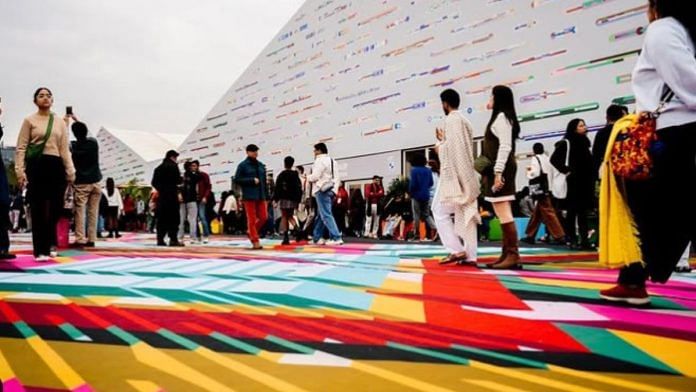New Delhi: The India Art Fair returns to Delhi, and as is their keep, the city descends in droves to Okhla’s NSIC grounds. Arguably South Asia’s biggest art mela, it’s the Art Avatar of the Kumbh. For artists and galleries, it’s essential to keep shops up and running.
But for viewers, appreciators, and those longing to lose themselves in an art-mediated void, it’s far is too crowded. And it’s intensifying by the year. The NSIC grounds appear to be lacking in infrastructure befitting these crowds of mythic proportions, and there’s an almost sad sameness to it all –– even 15 years after its first edition. The scope of art at the Fair doesn’t seem to have widened at all. It’s a gate that stubbornly refuses to accommodate diversity, to take stock of a culture that’s ever-changing.
This is as the throngs of people attending only expand.
An article on the recently completed Jaipur Literature Festival compared the hordes of people at Hotel Clarks Amer to those at the Kumbh. They probably weren’t wrong. And this mela too has adopted the same persona. At the end of the day, perhaps they’re all just pilgrimages. Places to be seen; to let people know: ‘we were here’. Meanwhile, everything else appears to be decorative, easily replaceable. The frenzied social media sharing, the drinks at the VIP bar, and this may be a bit of a stretch –– but the art too.
Also, there isn’t enough parking — and while of course, there’s an ample quantity of exceptions –– the crowd that frequents this gathering doesn’t exactly comprise those comfortable taking public transport.
However, crowd control (or the lack thereof) isn’t necessarily a criticism. It’s exciting that there are so many people clamouring to go to what ultimately is an ode to India’s cultural riches. But there is a definitive VIP culture at play. It’s a four-day festival, out of which only two are open to the ‘public’. The public in this case being those willing to fork out Rs 1,500 for a one-day pass. Even a student pass costs a pretty hefty Rs 800.
Devoid of context
In a piece for The Wire, renowned architect Gautam Bhatia talks about consistency. He attends the art fair each year and is consequently disappointed.
“The fair seems destined to grow within its own commercial bubble. Largely self conscious, insular and private, it remains fixated in an awkward mix of internationalism and Indian traditional art,” he writes.
This year, according to the official website, 85 galleries are exhibiting, both from India and around the world. As has been the case through the years, there’s a heavy focus on India’s modernists –– SH Raza, MF Husain, Raja Ravi Varma, and a rather exhilarating piece de resistance –– Gogi Saroj Pal’s final sculpture.
One of the most consistent criticisms of our art fair is that it exists in a vacuum –– it’s devoid of social context, of political place. But over the past few years at least, there’s always been some work that deals with questions of caste and various social inequalities. This year, for instance, Yogesh Barve, a Mumbai-based multi-modal artist, uses LED stickers that reflect the writings of BR Ambedkar, Jyotirao Phule, and Periyar.
It’s presumably work that’s loud and unequivocal in its positioning. Yet, when the space and those who frequent it practically take pride in sidestepping social realities, it’s difficult to harbour them simultaneously. And they possibly lose their meat, and then exist for aesthetic consumption.
Over the past decade or so, we’ve seen an out-and-out boom in the number of private galleries, with Delhi and Mumbai as prime locations –– home to an elite bubble akin to an art-appreciating culture. One would assume they’d also take on the responsibility of expanding art engagement. To take it beyond sanitised spaces, to an audience that resembles India. A herculean task, but one with an equally rich pay-off.
And the India Art Fair would be a great place to start.
Views are personal.
(Edited by Ratan Priya)






